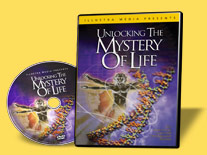
Resources
In The Origin of Species, Charles Darwin issued a challenge: “If it could be demonstrated that any complex organ existed, which could not possibly have been formed by numerous, successive, slight modifications, my theory would absolutely break down.” (First Edition, Chapter VI, p. 189) Darwin was confident that his challenge could not be met.
But according to a growing number of scientists, discoveries at the very foundation of life are proving Darwin wrong.
Like his contemporaries, Darwin did not have an accurate understanding of the complexity of the cell. Indeed, according to Darwin’s follower Ernst Haeckel, cells were basically “homogeneous and structureless globules of protoplasm” that could easily evolve new biological functions. But by the end of the twentieth century, scientists had discovered that the cell is actually unimaginably complex—like a miniaturized city, full of molecular machines. In Darwin’s Black Box (1996), Lehigh University biochemist Michael Behe proposed that these findings of modern biochemistry provided a convincing answer to Darwin’s challenge. Unlocking the Mystery of Life explores Behe’s concept of irreducible complexity and how many molecular machines do not appear to have been produced by an undirected Darwinian process of “numerous, successive, slight modifications.” Instead, they appear to be the product of intelligent design.
Unlocking the Mystery of Life also examines the ideas of mathematician and philosopher William Dembski who developed an explanatory filter that allows scientists to rigorously detect design in nature. The documentary gives examples from everyday life and current fields of science that use Dembski’s methods to detect design by finding specified complexity in nature.
For a discussion and study guide of Unlocking the Mystery of Life, see Unlocking the Mystery of Life Discussion and Study Guide, by Ryan Huxley of the IDEA Center.
Finally, Unlocking the Mystery of Life investigates how DNA is an information-rich system that functions like a software code. Philosopher of science Stephen C. Meyer explains how the information stored in the DNA leads to a powerful new argument for intelligent design.
With amazing computer animation of cellular processes like DNA transcription and translation and molecular machines like the bacterial flagellum, Unlocking the Mystery of Life offers a compelling and educational investigation of intelligent design in biology.
To discover more about the ideas and topics discussed in Unlocking the Mystery of Life, use the resources listed below.
Resources on Molecular Machines and Irreducible Complexity
Modern biology has discovered that cells are like miniaturized factories that function using micromolecular machines. Some of the the sources in this section do not favor intelligent design, but they explain the biochemical details of these machines, while others make the case that they are “irreducibly complex” and provide evidence for intelligent design.
Michael Behe, “Molecular Machines: Experimental Support for the Design Inference”
Irreducibly Complex: An Audio Interview with Michael Behe on the Bacterial Flagellum
Casey Luskin, “Molecular Machines in the Cell”
Molecular Machines Animations and Movies
“The Inner Life of the Cell” by XVIVO and Harvard University
Video: William Dembski on Molecular Machines and the Death of Darwinism
Resources on Detecting Design
The books and articles linked below explain concepts like the explanatory filter and specified complexity which scientists use to detect design in nature.
William Dembski, “The Explanatory Filter”
William Dembski, The Design Inference: Eliminating Chance Through Small Probabilities (Cambridge University Press, 1998)
William Dembski, “Detecting Design in the Natural Sciences”
Casey Luskin, “Intelligent design (ID) has scientific merit because it uses the scientific method to make its claims and infers design by testing its positive predictions” (OpposingViews.com, September 8, 2008)
Casey Luskin, “The Positive Case for Design”
William Dembski, The Design Revolution: Answering the Toughest Questions About Intelligent Design (InterVarsity Press, 2004)
Resources on Information and DNA
DNA contains language-based information that contains the programming code for the protein parts in living organisms. Explore the links in this section to learn how DNA provides compelling evidence for intelligent design.
Stephen C. Meyer, Signature in the Cell: DNA and the Evidence for Intelligent Design (HarperOne, 2009)
Stephen C. Meyer (narrator), Journey Inside The Cell Video
Stephen C. Meyer, “Not by chance: From bacterial propulsion systems to human DNA, evidence of intelligent design is everywhere” (National Post of Canada, 2005)
Stephen C. Meyer, “DNA and the Origin of Life: Information, Specification, and Explanation,” in Darwinism, Design, and Public Education (Michigan State University Press, 2003)
William Dembski, “Intelligent Design as a Theory of Information”
Casey Luskin, “A Response to Dr. Dawkins’ ‘The Information Challenge’” (Evolution News & Views, October 4, 2007)
Casey Luskin, “The NCSE, Judge Jones, and Citation Bluffs About the Origin of New Functional Genetic Information” (Evolution News and Views, March 2, 2010)
Resources on the Origins of Intelligent Design
Check out the books, articles, and podcasts linked below for more information on the history of intelligent design thinking and terminology.
Jonathan Witt, “A brief history of the scientific theory of intelligent design”
Stephen Meyer, “A Scientific History and Philosophical Defense of the Theory of Intelligent Design”
Thomas Woodward, Doubts About Darwin: A History of Intelligent Design (Baker Academic, 2003) and Darwin Strikes Back: Defending the Science of Intelligent Design (Baker Academic, 2006)
Casey Luskin, “ID Does Not Address Religious Claims About the Supernatural” (Opposing Views.com, 2007)
“The Mystery of Life’s Origin: An Interview with Dr. Charles Thaxton,” Part One and Part Two (ID the Future Podcast, July 21 and 25, 2008)

